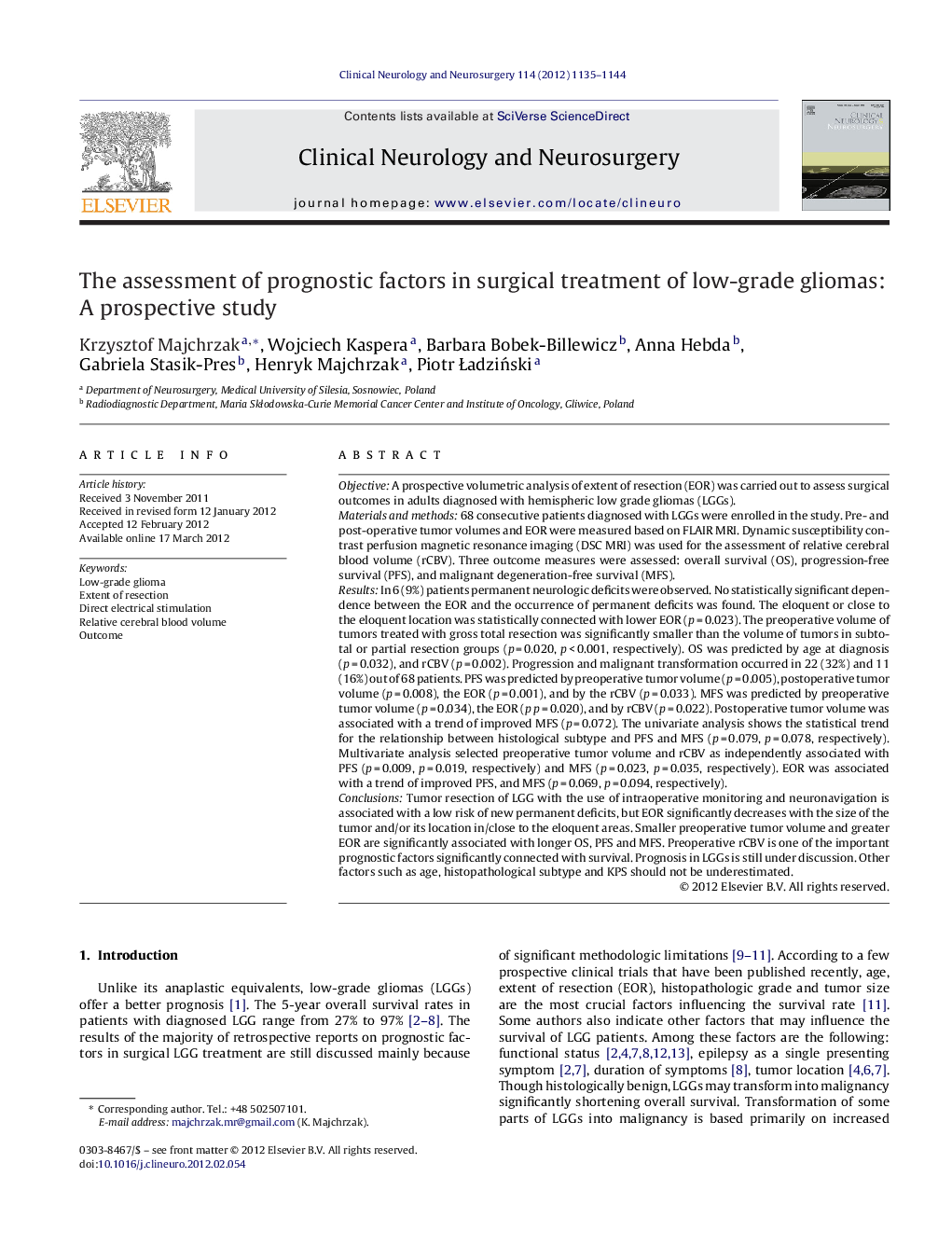| کد مقاله | کد نشریه | سال انتشار | مقاله انگلیسی | نسخه تمام متن |
|---|---|---|---|---|
| 3040901 | 1184753 | 2012 | 10 صفحه PDF | دانلود رایگان |

ObjectiveA prospective volumetric analysis of extent of resection (EOR) was carried out to assess surgical outcomes in adults diagnosed with hemispheric low grade gliomas (LGGs).Materials and methods68 consecutive patients diagnosed with LGGs were enrolled in the study. Pre- and post-operative tumor volumes and EOR were measured based on FLAIR MRI. Dynamic susceptibility contrast perfusion magnetic resonance imaging (DSC MRI) was used for the assessment of relative cerebral blood volume (rCBV). Three outcome measures were assessed: overall survival (OS), progression-free survival (PFS), and malignant degeneration-free survival (MFS).ResultsIn 6 (9%) patients permanent neurologic deficits were observed. No statistically significant dependence between the EOR and the occurrence of permanent deficits was found. The eloquent or close to the eloquent location was statistically connected with lower EOR (p = 0.023). The preoperative volume of tumors treated with gross total resection was significantly smaller than the volume of tumors in subtotal or partial resection groups (p = 0.020, p < 0.001, respectively). OS was predicted by age at diagnosis (p = 0.032), and rCBV (p = 0.002). Progression and malignant transformation occurred in 22 (32%) and 11 (16%) out of 68 patients. PFS was predicted by preoperative tumor volume (p = 0.005), postoperative tumor volume (p = 0.008), the EOR (p = 0.001), and by the rCBV (p = 0.033). MFS was predicted by preoperative tumor volume (p = 0.034), the EOR (p p = 0.020), and by rCBV (p = 0.022). Postoperative tumor volume was associated with a trend of improved MFS (p = 0.072). The univariate analysis shows the statistical trend for the relationship between histological subtype and PFS and MFS (p = 0.079, p = 0.078, respectively). Multivariate analysis selected preoperative tumor volume and rCBV as independently associated with PFS (p = 0.009, p = 0.019, respectively) and MFS (p = 0.023, p = 0.035, respectively). EOR was associated with a trend of improved PFS, and MFS (p = 0.069, p = 0.094, respectively).ConclusionsTumor resection of LGG with the use of intraoperative monitoring and neuronavigation is associated with a low risk of new permanent deficits, but EOR significantly decreases with the size of the tumor and/or its location in/close to the eloquent areas. Smaller preoperative tumor volume and greater EOR are significantly associated with longer OS, PFS and MFS. Preoperative rCBV is one of the important prognostic factors significantly connected with survival. Prognosis in LGGs is still under discussion. Other factors such as age, histopathological subtype and KPS should not be underestimated.
Journal: Clinical Neurology and Neurosurgery - Volume 114, Issue 8, October 2012, Pages 1135–1144